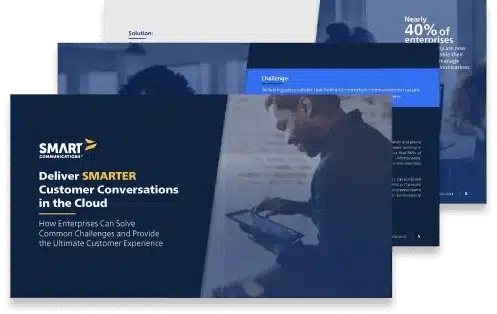Top Customer Experience Stats in 2025: Forms & Communications

By Smart Communications
As you’re thinking about planning and strategy in the year ahead, here’s a quick-hit roundup of some of the most compelling insights from Smart Communications’ 2025 Global CX Benchmark Report—broken into two critical categories: forms and communications.
Communications
- 84% of customers say communications impact their overall experience with a company—this jumps to 88% among Millennials and 89% in markets like the U.S. and Singapore.
- 75% say communications directly influence their satisfaction with a company. Nearly half (48%) say it drives loyalty—with the U.S. leading at 54%.
- A striking 67% say they’d switch providers if communications don’t meet expectations. That’s up from 51% in 2023—a 16-point jump in just two years.
- 78% say they'd recommend a company if communications exceed expectations.
- Only 62% currently rate the communications they receive as "good" or "excellent"—despite massive investments in CX tech.
- Trust is on the line: Just 63% say they trust their providers most of the time. This dips to 57% among Gen Z.
- 60% of consumers trust companies more when communications are consistent across channels—and younger generations care even more (Millennials: 68%).
- Preferred channels:
- Email (43%)
- SMS (18%)
- Web/app-based communication (13%).
- Response time matters most in good communications—cited by 89% globally.
- AI’s role is growing:
- 61% believe GenAI will improve CX
- 46% want a human in the loop to check content AI generates
- 53% see faster response times as AI’s biggest benefit in communications
11. Channel usage gaps exist across industries (e.g., only 56% of banks use preferred channels, and this is down from 60% in 2024).
12. Generational views differ (e.g., Millennials are most likely to recommend a company based on comms).
13. Trust levels vary by region (e.g., trust highest in USA at 71%, lowest in Australia at 59%).
14. Only 54% overall are satisfied with omnichannel experiences.
15. GenAI confidence gaps linger (only 46% confident it handles info securely).
16. AI usage transparency matters to 37%.
17. Only 13% think GenAI is better than humans at communications.
18. Biggest benefits of AI in comms: faster responses (53%), accuracy (44%), cost savings (42%).
19. Top concerns with AI: privacy (49%), lack of human oversight (43%), potential errors (39%).
Forms/Data Collection
- 66% of people say they’d abandon an interaction entirely if a form is too hard to complete.
- The most important features in a form are:
- 92% demand 100% security
- 90% want it fast and easy
- 85% say only relevant questions should be asked
- 83% expect mobile/web-friendly design
- 84% want to save progress and return later
- Frustration drivers include:
- Repeating info: 60%
- Redundant questions: 57%
- Lack of save/resume: 49%
- Paper/manual processes: 40%, higher among Millennials at 47%
- If the data collection experience is positive:
- 64% say they’d stay loyal
- 56% would buy more
- 54% would leave a good review
- 71% prefer digital self-service over calling—rising to 83% among Millennials.
- 63% prefer guided digital forms over PDFs. This is even higher among Gen X and Boomers (67% each).
- 77% say digital intake is important—especially in healthcare (79%) and among Millennials (84%).
- 66% consider data collection a form of communication.
- Form updates matter:
-
- Over 50% want status updates after submission.
- In healthcare specifically, 51% actively want to know the status of their submitted forms.
10. When people inquire about the status of a request, most still rely on email (44%) or phone (45%). Chatbots remain underused, at just 9–12% usage.
11. Real-time help desired by 81%.
12. Status updates post-submission matter to 83%.
13. Guided digital forms preferred by 63%.
14. Form issues drive drop-off: too time-consuming (57%).
15. Too hard to upload documentation: 62% abandon.
16. Forms are described as time-consuming by 41%.
17. Forms are a method of communication according to 66% of respondents.
18. Self-service is preferred by 71% overall.
19. 79% of healthcare consumers say digital intake matters.
20. 56% would engage with an organization more if the intake process exceeds expectations.
Quick Recap and Takeaways of the 2025 CX Benchmark Research
- Forms that frustrate users drive immediate drop-offs. Even one confusing step can push users to give up—permanently.
- AI-powered customization during intake builds trust—but only if it's clearly explained and ethically implemented. Over 40% still worry about data privacy and human oversight.
- Poor communications fuel churn. It’s no longer just about what you say—but how fast, how clear, and how personal it is.
- Consistency across channels isn’t a nice-to-have—it’s a trust builder. Younger generations especially expect seamless, cross-channel experiences.
Why These 2025 Stats Matter Across Industries
Customer expectations are rising across the board—but what really matters differs slightly depending on your industry. Here's how the findings play out in four key sectors:
Insurance: Retention Is on the Line
- Only 23% of insurance customers say they are very satisfied when making account or policy changes.
- 55% say insurers communicate on their preferred channels—but 14% say they rarely or never do.
- 45% of insurance customers still rely on phone calls for status updates, while email matches at 45%. Chatbots trail at just 9%.
- If the data collection process exceeds expectations, 56% would recommend their insurer and 64% would remain loyal.
- Data privacy and human oversight are major concerns for insurance customers:
- 47% are concerned about privacy
- 43% worry about lack of human involvement in AI-driven comms
Takeaway: Personalized, omnichannel communications and streamlined digital intake are critical to both winning trust and avoiding churn in a competitive market.
Get more exclusive insights in our full 2025 Insurance Benchmark Report.
Financial Services: Communication = Confidence
- Only 28% of FS customers are very satisfied with their experience making changes to their account.
- Banks & FS providers are only hitting the mark 56% of the time when it comes to using a customer's channel of choice—down from 60% in 2024.
- Trust is fragile: Only 63% of customers say they trust their bank or FS provider “always” or “almost always.” That’s down from 68% last year.
- 61% say they’d drop out of a form-based process if it’s too difficult.
- When submitting forms, 43% want updates on their request status—but only 12% use chatbots to inquire.
Takeaway: In Financial Services, clarity and confidence go hand-in-hand. Fast, secure, and intuitive interactions—especially around data collection—are table stakes.
Watch the video below for more FS benchmark insights, then check out the full report.
Healthcare: Data Intake Drives Loyalty
- Only 24% of customers are very satisfied with their service when making changes to an account.
- 51% of healthcare customers want status updates after submitting forms—more than any other industry.
- 70%+ say they’d abandon a form if it’s too time-consuming or asks for the same information repeatedly.
- 79% of healthcare customers say it’s important to offer digital data collection instead of manual processes.
- Healthcare organizations lead in AI adoption willingness:
-
- 54% find AI-generated health advice valuable
- 57% of Millennials say AI-generated health recommendations would improve their experience
Takeaway: Simplifying forms and communicating proactively—especially around coverage, claims, and status—can significantly improve satisfaction and trust.
Discover more surprising stats in our full 2025 Healthcare Benchmark Report.
Healthcare Communications Should Be Personalized and Prompt
- Just 24% of healthcare customers are very satisfied with provider experiences when making account or information updates.
- Email and phone are still dominant—but 57% of customers prefer communications via web, mobile app, or encrypted messaging.
- 51% of healthcare consumers expect updates on form status, especially Gen Z and Millennials.
- 63% of healthcare customers say they’re likely to use digital self-service for support tasks—rising to 73% among Gen Z and Millennials.
- 81% of healthcare customers say they’re more likely to recommend a provider if communications exceed expectations.
Takeaway: Healthcare organizations have an opportunity to deepen trust by offering fast, secure, and channel-flexible experiences—especially with younger, digital-first patients and members.
For more insights into the research, including filterable views across geographies, demographics, and industries, access the full interactive Benchmark experience now.



